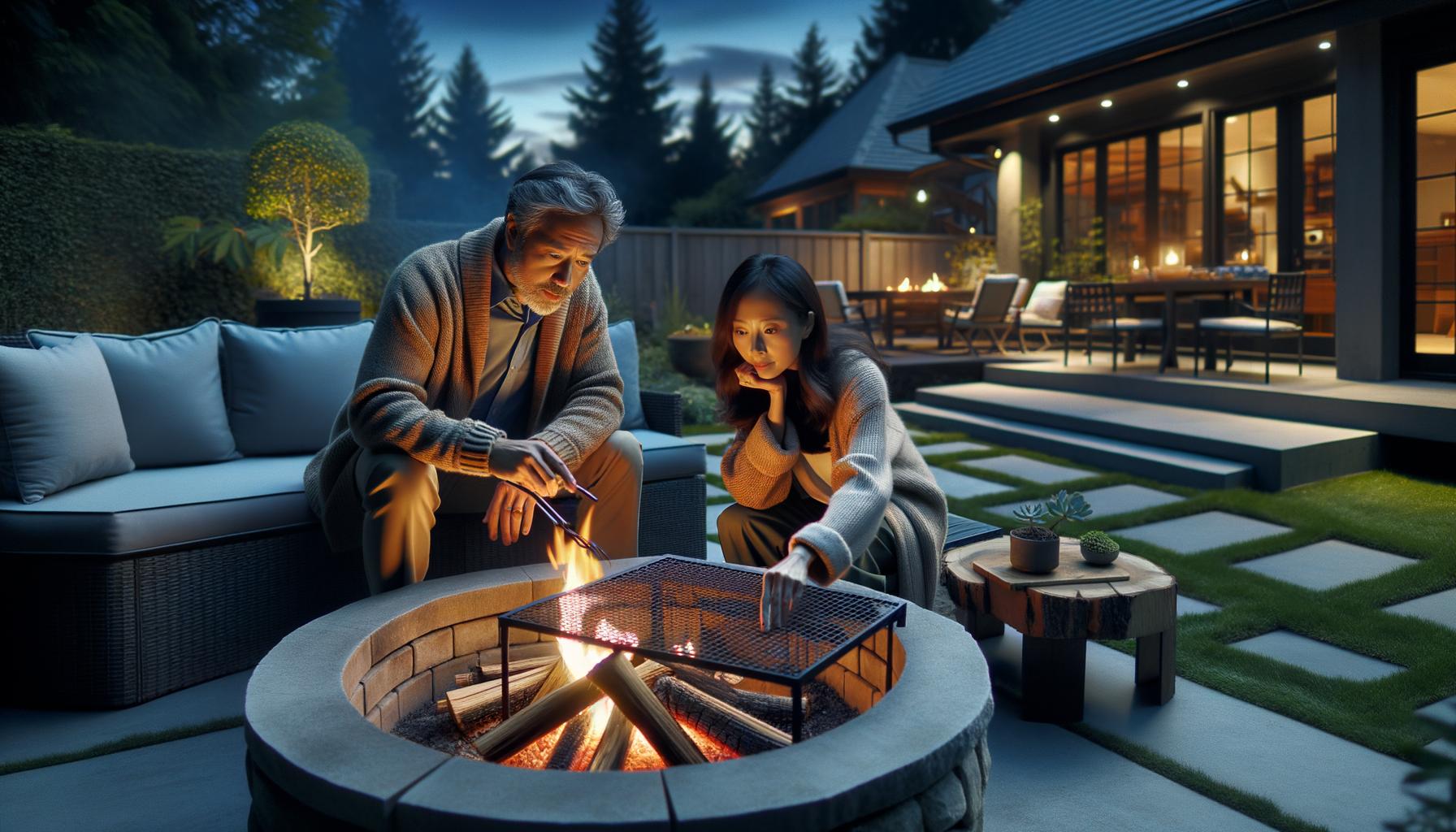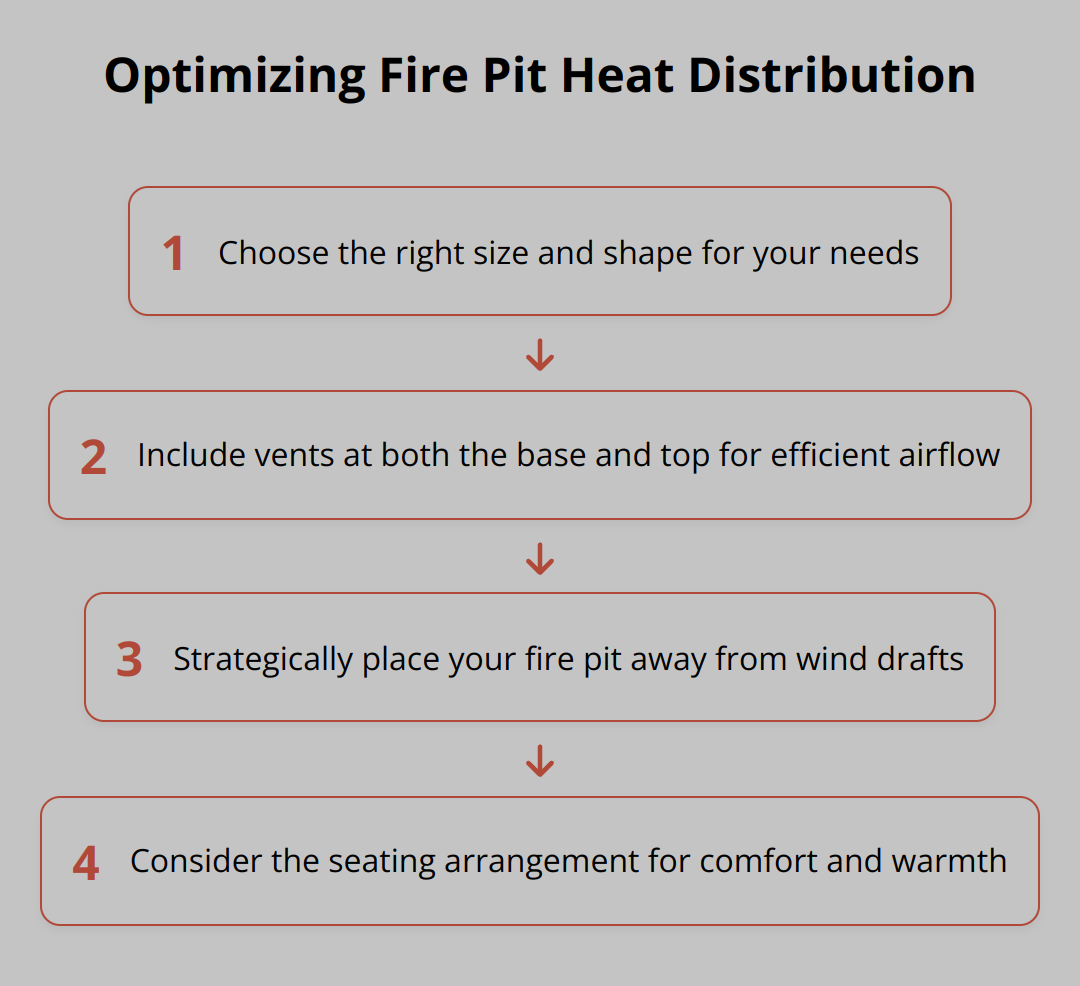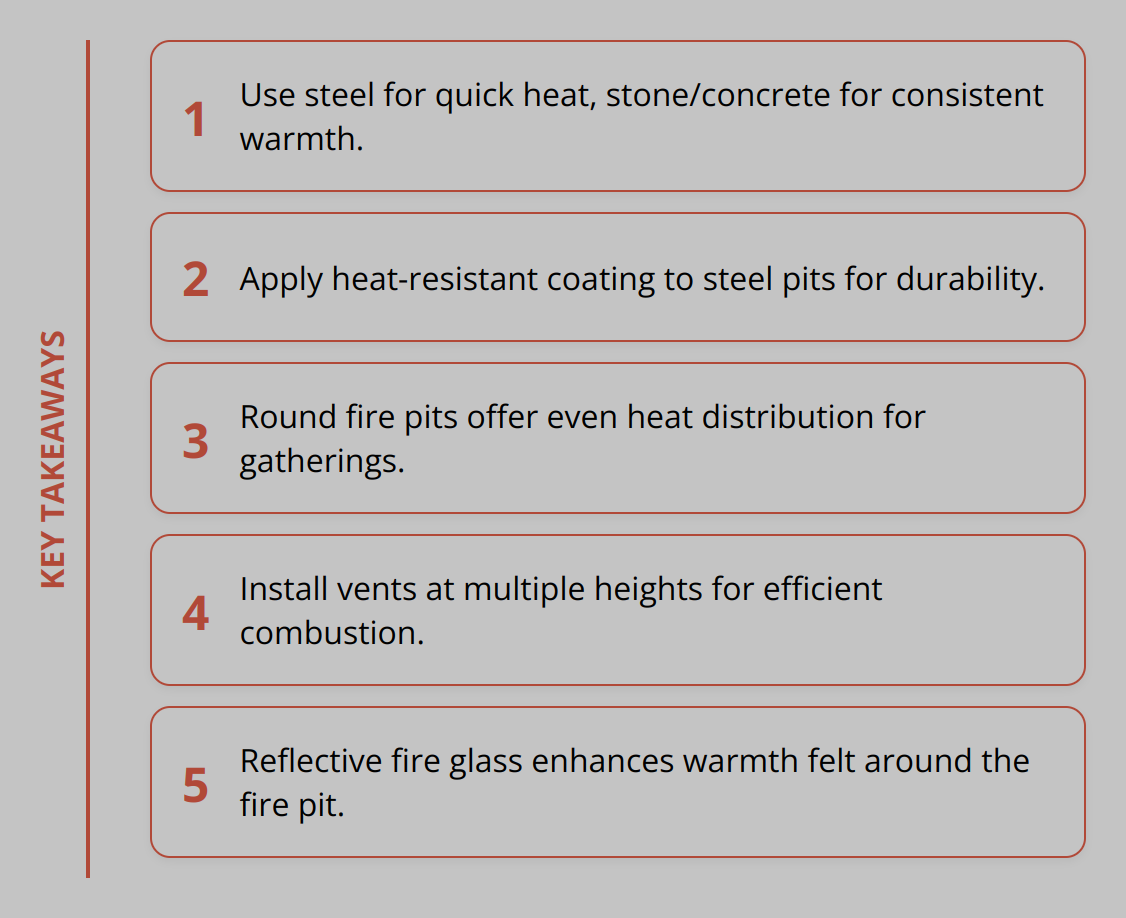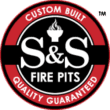
Maximizing the warmth from your fire pit not only enhances your outdoor experience but also ensures your gatherings are cozy and comfortable. Here at S&S Fire Pits, we understand the science and art behind optimal heat distribution.
This guide will explore everything from selecting the right materials to design considerations and useful accessories. Join us as we share expert insights to help you enjoy those memorable nights around the fire even more.
Optimizing Fire Pit Heat
When it comes to optimizing the warmth of your fire pit, selecting the right material is key. This is because materials differ in how well they conduct and retain heat, directly impacting the efficiency and overall warmth of your fire pit. Understanding these properties can profoundly influence your choice, leading to more enjoyable and warmer outdoor gatherings.
Heat Conductivity and Retention Explained
Materials with high heat conductivity absorb and transfer heat quickly, making them ideal for rapid warming of your space. Conversely, materials with high heat retention store heat for longer periods, continuing to radiate warmth even as the fire diminishes.
Material Matters
The most common materials for fire pits are steel, stone, and concrete. Steel, especially when thick like the corten steel we use in all of our fire pits, offers excellent heat conductivity and, given the right conditions, can also retain heat well. It’s a strong choice for those looking for quick heat. However, its longevity and performance can be affected by rust if not properly maintained or treated.
Stone and concrete, while not as conductive as steel, excel in heat retention. They absorb heat slowly but release it steadily, ensuring a consistent warmth over time. These materials are perfect for prolonged use, making them ideal for extensive evening gatherings.

Selecting the Best Material
When choosing the best material for your fire pit, consider the following:
- Durability: Look for materials that can withstand high temperatures and resist weathering.
- Heat Output: If quick warmth is what you’re after, prioritize conductive materials like steel. For longer, more consistent heat, stone or concrete might be your best bet.
- Maintenance: Consider how much time and effort you’re willing to invest in maintaining your fire pit. Steel may require more care to prevent rust, whereas stone and concrete are generally low maintenance.
- Aesthetics: Ultimately, your fire pit should complement your outdoor space. Choose a material that aligns with your style preferences.
Practical Tips
- For steel fire pits, applying a heat-resistant coating can enhance durability and rust resistance. But, be warned that it will likely need to be something that is done annually as no coatings that we are aware of can withstand repeated high heat environments.
- Placing a layer of sand at the bottom of a stone or concrete fire pit can improve heat distribution.
- Regular cleaning and removal of ash will maintain optimal airflow and heat performance, regardless of material.
For more insights on maintaining your fire pit, check out our guide on fire pit maintenance tips.
Selecting the right material for your fire pit is more than just a matter of preference. It’s about understanding the balance between conductivity and retention to maximize warmth and efficiency. With this knowledge, you’re well on your way to creating unforgettable moments around the fire.
Enhancing Heat Distribution
A fire pit is not just a fire pit. Its design, from shape and size to location and ventilation, plays a pivotal role in how well it distributes heat. Get these elements right, and your fire pit will become the heart of cozy, comfortable gatherings, warming everyone equally and effectively. Let’s break down how to make the best choices for heat optimization.
The Right Shape and Size Matter
The shape and size of your fire pit directly affect how heat is distributed. Round fire pits are excellent for gatherings, as they distribute heat evenly in all directions, allowing people to circle around and receive equal warmth. Square or rectangular pits might focus heat more on one side, but they fit better in certain spaces and can still provide ample warmth if designed correctly.
The size should match the intended use. A larger pit will emit more heat, making it suitable for bigger spaces or gatherings. However, it will require more fuel. A smaller pit is perfect for intimate settings and uses less fuel, but it might struggle to keep a large group warm. Therefore, it’s essential to match the fire pit’s dimensions with both your space and your typical guest count.

Ventilation is Key
Optimal airflow through strategic vent placement is crucial for efficient combustion, as it directly influences heat production. Vents should be located both near the bottom to allow oxygen to fuel the flames and higher up to let smoke escape, creating a circulation of air that feeds the fire and distributes heat more effectively. Without proper ventilation, a fire may burn less vigorously, producing less heat and more smoke.
Location Influences Warmth
Positioning your fire pit is as important as its design. For the best heat distribution, place your fire pit in a central area away from wind drafts. Drafts can cool down the area and make the fire burn unevenly, impacting warmth distribution. Moreover, consider the seating arrangement around your fire pit. Ensure there’s enough space for people to move back if it gets too warm, but also close enough to feel the heat on cooler nights.

Practical Tips:
- Measure your space to determine the best size for your fire pit.
- Choose a round fire pit for even heat distribution in social settings.
- Ensure your fire pit design includes vents at multiple heights.
- Based on layout and prevailing winds, strategically place your fire pit to avoid drafts.
- Arrange seating to adjust to varying warmth needs.
Optimizing heat distribution requires careful consideration of your fire pit’s design and placement. By focusing on these aspects, you create not just an outdoor feature but a source of warmth and comfort that enhances every gathering. Have look at outdoor fire safety tips to ensure your cozy nights are also safe nights. Your fire pit can then serve as a focal point for memorable outdoor experiences, radiating not just warmth, but also ambiance and conviviality.
Elevating Heat Efficiency
To ensure your outdoor gatherings remain comfortably warm, enhancing your fire pit’s heat output and distribution is essential. Beyond choosing the right materials and design, accessories play a pivotal role in achieving efficient warmth. From safety to comfort enhancements, the right accessories not only protect but also significantly improve your fire pit experience.
Safety and Efficiency Combined
One often overlooked accessory that significantly impacts safety and heat efficiency is the fire pit screen. While its primary purpose is to prevent embers and sparks from escaping, it also influences heat distribution. A well-designed fire pit screen can help direct heat outward toward your guests rather than upward, making those around the fire feel warmer. Always opt for a screen that fits well with your fire pit’s size and shape for optimal results.
Reflecting Warmth
Reflective fire glass acts as more than just a visually appealing accessory. Its ability to reflect heat makes it a valuable asset for those looking to elevate their fire pit’s warmth. By replacing or covering the base material of your fire pit with fire glass, you can efficiently direct heat toward your sitting area, enhancing the overall warmth felt by everyone.
Circulate for Better Warmth
The introduction of a grate into your fire pit setup encourages elevated air circulation, a key factor in efficient burning and heat distribution. A grate raises the wood, allowing oxygen to fuel the fire from underneath and thereby producing a hotter, more consistent flame. This not only maximizes the heat output but also ensures a more even distribution of warmth around the fire pit. Grates are especially recommended for larger fire pits to maintain an engaging fire that radiates an ample amount of heat.

For a deeper dive into ensuring your fire gatherings are safe and enjoyable, consider exploring our comprehensive guide on outdoor fire safety tips.
Practical Tips:
- Invest in a high-quality fire pit screen to increase safety and heat direction.
- Utilize reflective fire glass at the base of your fire pit for enhanced warmth reflection.
- Grates can significantly improve air circulation leading to a hotter and more evenly distributed warmth.
Optimizing your fire pit’s heat efficiency is not just about the materials or the design; it’s also about enhancing and complementing its functionality with the right accessories. Accessories like screens for safety, reflective glass for heat reflection, and grates for better air circulation work synergistically, transforming your fire pit into an efficient source of warmth and comfort. By incorporating these elements, you ensure that your fire pit not only looks good but also performs exceptionally, making every outdoor gathering a warm and memorable one.
Final Thoughts
Optimizing heat distribution in your fire pit is key to extending those enjoyable outdoor gatherings into the cooler evenings and seasons. As we’ve explored, the choice of material, the design, and strategic placement of your fire pit, along with the addition of practical accessories, plays a crucial role in enhancing warmth and comfort.

Material choice is paramount. High heat conductivity and retention properties of materials like steel, stone, and concrete directly impact the warmth your fire pit can provide. Steel, known for its quick heat-up times, and stone or concrete, celebrated for their prolonged heat release, offer options for every type of gathering.
Design considerations such as the shape, size, and ventilation of your fire pit influence how heat is distributed to those around it. A round design promotes even heat distribution, making it ideal for group settings, while proper ventilation facilitates a stronger, more efficient flame.
Placement is also critical. To avoid drafts and maximize warmth, positioning your fire pit in a sheltered yet central location can make a significant difference in the comfort of your guests.
Incorporating accessories like fire pit screens, reflective fire glass, and grates can further enhance your fire pit’s efficiency. These additions not only improve safety but also elevate the warmth felt by everyone, ensuring a cozy atmosphere.
We encourage you to experiment with these elements to find what works best for your outdoor space. Every setup is unique, and making small adjustments can have a big impact on your experience.
At S&S Fire Pits, we understand the importance of creating a welcoming and warm outdoor space. Our handcrafted, solid steel fire pits are designed not just for warmth, but as an inviting centerpiece for any gathering. With our durable and aesthetically pleasing designs, rest assured that your outdoor experiences will be unforgettable.
Remember, your outdoor living space is an extension of your home. By selecting the right fire pit, optimizing its heat distribution, and adding the right touches, you transform any outdoor setting into a year-round haven for family and friends to gather.


